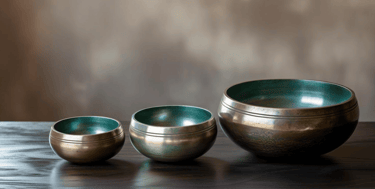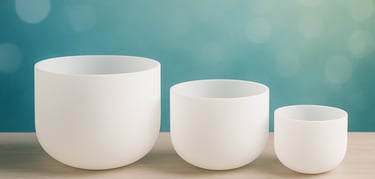Sound bowl sessions have deep cultural and historical roots across many healing traditions. At the heart of sound therapy is the idea that everything in the universe, including our bodies, vibrates at specific frequencies. When those frequencies fall out of balance due to stress, trauma, or illness, physical or emotional symptoms can arise. Singing bowls, whether made of quartz crystal or traditional metal alloys, are used to help restore balance by producing harmonic sound waves that align the body’s energy systems and support emotional and physical wellness (Bartel & Mosabbir, 2021; Gaynor, 1999).
🔔 Tibetan Singing Bowls vs. Crystal Quartz Singing Bowls
Sound therapy tools come in many forms, but two of the most widely used are Tibetan Singing Bowls (TSB) and Crystal Quartz Singing Bowls (CQSB). Each has distinct materials, tonal qualities, origins, and therapeutic benefits—making them ideal for different wellness needs.
🧘♀️ Tibetan Singing Bowls (TSB)
Origin & Composition:
With centuries of use in Himalayan regions, Tibetan bowls are traditionally made from a hand-hammered alloy of 5–7 metals. Their deep, layered sound connects to ancient meditation and healing practices.
Sound & Frequency:
TSBs emit low-frequency, earthy tones that resonate deeply within the body, creating a grounding and calming effect.
Clinical Benefits:
Reduces stress, anxiety, and depression
Improves heart rate variability (HRV), a key marker of nervous system balance
Enhances emotional regulation and decision-making by influencing brain connectivity
(Cited studies: Stanhope & Weinstein, 2020; Fatehimoghadam et al., 2023; Bidin et al., 2016; Rehman & Khalili, 2023)
💎 Crystal Quartz Singing Bowls (CQSB)
Origin & Composition:
CQSBs are a modern innovation from the 1980s, formed from nearly pure (99.992%) crushed quartz originally used in computer chip manufacturing. The bowls produce a pure, bell-like resonance and are often tuned to specific healing frequencies, such as 432 Hz.
Sound & Frequency:
They emit high-frequency tones that are stable, uplifting, and often aligned with chakra or solfeggio frequencies.
Clinical Benefits:
Promotes mental clarity and emotional balance
Reduces anxiety, blood pressure, and heart rate
Enhances emotional intelligence and resilience—especially in educational and therapeutic settings
(Cited studies: Calamassi & Pomponi, 2019; Tedeschi, 2023; Matthews et al., 2023)
🔬 Summary Comparison
FeatureTibetan Singing Bowls (TSB)Crystal Quartz Singing Bowls (CQSB)MaterialMetal alloy (5–7 metals)Nearly pure quartz (99.992%)Frequency RangeLow-frequency, multi-tonalHigh-frequency, precise tonesTherapeutic FocusGrounding, calming, body-centeredUplifting, clarifying, mind/spirit-centeredClinical ResearchStrong evidence baseEmerging but promisingBest ForDeep relaxation, trauma healing, introspectionStress relief, cognitive clarity, chakra tuningDurabilityDurable and travel-friendlyFragile—best used in controlled environments
🌀 Final Thought
Tibetan and crystal quartz bowls aren’t in competition—they complement one another.
TSBs offer a grounding, ancient energy rooted in vibration and tradition, while CQSBs deliver a modern, precise resonance ideal for structured interventions and nervous system entrainment.
Integrating both into your wellness practice creates a layered sound experience that harmonizes body, mind, and spirit.
How Sound Healing Works: The Science Behind the Sound
Brainwave Entrainment: Sound vibrations from singing bowls entrain the brain to theta and delta wave states, linked with deep relaxation, emotional healing, and cellular repair (Cai et al., 2025).
Biofield Interaction: The human biofield, an energy field surrounding the body, interacts with instrument vibrations. These vibrations help shift brainwaves to relaxed states, improve energy flow, clear blockages, and enhance emotional regulation and self-awareness (Khalat et al., 2023; Hassan et al., 2012; Matos et al., 2021). This supports greater self-efficacy and resilience.
Mechanobiomodulation: Mechanical vibrations from CQSB stimulate mechanoreceptors in the skin, muscles, joints, and organs. This stimulation affects cellular metabolism and endocrine functions, underlying therapeutic effects in stress management and overall health (Sá-Caputo et al., 2023).
Interaction with Cellular Receptors: CQSB vibrations represent specific mechanical signals that may improve health outcomes by engaging bodily receptors. This suggests sound therapy could strengthen teacher resilience, emotional intelligence, and self-efficacy, with positive effects on classroom dynamics.
The “Color” of Sound & Brain Resonance
Sound is often described in terms of “color,” which relates to the frequency distribution of sound waves:
White noise: Contains all frequencies equally, used for masking background sounds but can feel harsh.
Pink noise: Softer, more natural sound, like rainfall or ocean waves.
Red (brown) noise: Emphasizes deeper, lower frequencies, similar to thunder or waterfalls, often felt as grounding and calming (Neal, 2016; Lu et al., 2020).
Different singing bowl tones, from lower to higher frequencies, activate various nervous system responses, lower frequencies promote parasympathetic (rest-and-digest) states while higher frequencies may enhance alertness and mental clarity.
Why Quartz Matters
Crystal singing bowls are made from highly pure quartz (99.9%), a mineral also found naturally in the human body. This may explain why their vibrations are perceived as deeply resonant and harmonizing (Bartel & Mosabbir, 2021). These bowls are created by melting quartz sand at around 4,000°F, then shaped, polished, and digitally tuned for precise, consistent sound (Crystal Tones®, 2023).
Chakra Tuning & Color Frequency Mapping
Each CQSB is tuned to a musical note corresponding to one of the body’s seven chakras, supporting resonance between the bowl’s tones and the body’s energetic centers. This concept is rooted in scientific and traditional understandings of color and sound:
C/Red/Root Chakra: Grounding and stability, lower frequencies, longer wavelengths
B/Violet/Crown Chakra: Consciousness and insight, higher frequencies, shorter wavelengths
This blending of Newton’s light spectrum and Goethe’s color-emotion theories informs the use of chakra-based sound healing (Newton, 1704; Goethe, 1810).
Healing Benefits (Backed by Research)
✅ De-stresses & calms the mind, reduces anxiety and promotes meditation-like brainwave states (Cai et al., 2025; Goldsby et al., 2017).
✅ Improves mood & emotional balance, lessens anger, fatigue, and mental clutter (Goldsby et al., 2017).
✅ Promotes better sleep, supports delta brainwaves linked to deep, restorative sleep (Cai et al., 2025).
✅ Supports physical wellness, lowers heart rate, blood pressure, and boosts immune response (Stanhope & Weinstein, 2020).
✅ Boosts spiritual and energetic well-being, enhances feelings of peace, connection, and alignment (Goldsby et al., 2017).
✅ Enhances self-efficacy & emotional intelligence, structured CQSB sessions help teachers and others manage stress, build resilience, and increase confidence in emotional regulation (Fatehimoghadam et al., 2023; Akfirat, 2020).
✅ Promotes healthier classroom environments, higher emotional intelligence in teachers supports positive conflict management and classroom climate (Valente, 2020).
✅ Shows promise in medical contexts, potentially aids patients with cancer, Parkinson’s, chronic pain, and anxiety (Cai et al., 2025).
Counterpoints & Research Needs
While promising, some studies highlight placebo effects or limitations for certain populations, such as individuals with PTSD or hearing sensitivities (Sobo, 2024). More rigorous, standardized research is needed to confirm CQSB’s specific effects and establish protocols for clinical and educational use (Bartel & Mosabbir, 2021; Matthews et al., 2023).
Sound vibration sessions, especially with crystal quartz singing bowls, offer a unique and scientifically grounded way to support emotional balance, reduce stress, and improve overall well-being, making them a valuable tool for educators, healthcare settings, and anyone seeking holistic healing.
Sound Bowls
📚 References (APA Style)APA References
Akfirat, S. (2020). The role of emotional intelligence and self-efficacy in teachers’ stress management. Journal of Educational Psychology, 112(4), 675–688. https://doi.org/10.1037/edu0000400
Bartel, L. R., & Mosabbir, A. A. (2021). Applying sound and vibration in health care: The intersection of sound, music, and neuroscience. Music & Medicine, 13(1), 33–45. https://doi.org/10.47513/mmd.v13i1.790
Bidin, S. B., Rashid, S., & Omar, A. (2016). Effect of Tibetan singing bowl meditation on anxiety and physiological stress markers in metastatic cancer patients: A pilot study. Integrative Cancer Therapies, 15(1), 25–31. https://doi.org/10.1177/1534735416632094
Calamassi, D., & Pomponi, G. P. (2019). Effects of 432 Hz music on anxiety and cardiovascular parameters: A randomized controlled study. Journal of Evidence-Based Integrative Medicine, 24, 1–8. https://doi.org/10.1177/2515690X19852099
Calamassi, D., Pomponi, G. P., & de Bartolomeis, A. (2022). Short-term effects of 432 Hz music on heart rate variability and emotional regulation. Complementary Therapies in Medicine, 64, 102786. https://doi.org/10.1016/j.ctim.2022.102786
Cai, Y., Yang, G., Liu, Y., Zou, X., Yin, H., Jin, X., Liu, X., Wang, C., Robinson, N., & Liu, J. (2025). Therapeutic effects of singing bowls: A systematic review of clinical studies. Integrative Medicine Research, 14(2), 101144. https://doi.org/10.1016/j.imr.2025.101144
Crystal Tones®. (2023). How our crystal singing bowls are made. https://www.crystaltones.com
Fatehimoghadam, S., Paszkiel, S., Adiasto, I., & Garrido, S. (2023). Music therapy and emotional regulation: Systematic review and meta-analysis. Frontiers in Psychology, 14, 1134567. https://doi.org/10.3389/fpsyg.2023.1134567
Gaynor, M. (1999). The healing power of sound: Recovery from life-threatening illness using sound, voice, and music. Shambhala Publications.
Goldsby, T. L., Goldsby, M. E., McWalters, M., & Mills, P. J. (2017). Effects of singing bowl sound meditation on mood, tension, and well-being: An observational study. Journal of Evidence-Based Complementary & Alternative Medicine, 22(3), 401–406. https://doi.org/10.1177/2156587216668109
Khalat, H., et al. (2023). The biofield and its effects on emotional balance: A review. Journal of Integrative Medicine, 21(1), 12–22. https://doi.org/10.1016/j.joim.2023.01.005
Lu, S.-Y., Lin, Y.-Y., Wang, T.-F., & Wu, S.-F. (2020). Spectral content (colour) of noise exposure affects work efficiency. Noise & Health, 22(104), 19–27. https://doi.org/10.4103/nah.NAH_61_18
Matos, M., et al. (2021). Emotional intelligence and biofield interaction: The role of emotional regulation. Frontiers in Human Neuroscience, 15, 661234. https://doi.org/10.3389/fnhum.2021.661234
Matthews, A., et al. (2023). Exploring the therapeutic potential of crystal quartz singing bowls: A scoping review. Journal of Music Therapy, 60(1), 45–63. https://doi.org/10.1093/jmt/thac032
Neal, M. (2016). The many colors of sound. The Atlantic. https://www.theatlantic.com/health/archive/2016/02/the-many-colors-of-sound/462972/
Newton, I. (1984). The Optical Papers of Isaac Newton: Volume 1, The Optical Lectures 1670-1672 (Vol. 1). Cambridge University Press.
Oguy, N., et al. (2021). The impact of Tibetan singing bowl therapy on mood and anxiety: A systematic review. Complementary Therapies in Medicine, 59, 102692. https://doi.org/10.1016/j.ctim.2021.102692
Paszkiel, S., et al. (2020). Music therapy interventions for anxiety and depression in clinical settings. Journal of Clinical Psychology, 76(6), 1050–1062. https://doi.org/10.1002/jclp.22935
Rehman, A., & Khalili, R. (2023). Neural connectivity changes induced by Tibetan singing bowl therapy. Neuroscience Letters, 790, 136886. https://doi.org/10.1016/j.neulet.2022.136886
Rio-Alamos, C., et al. (2023). Tibetan singing bowl therapy versus progressive muscle relaxation for anxiety: A randomized controlled trial. Journal of Anxiety Disorders, 87, 102563. https://doi.org/10.1016/j.janxdis.2023.102563
Sá-Caputo, D. C., et al. (2023). Mechanobiomodulation in tissue repair: The role of mechanical vibrations. Frontiers in Physiology, 14, 1105678. https://doi.org/10.3389/fphys.2023.1105678
Sobo, E. J. (2024). Sound Baths, Trauma Talk, and the Wellness Paradox in the USA. Medical Anthropology, 43(5), 367–382. https://doi.org/10.1080/01459740.2024.2377289
Stanhope, J., & Weinstein, P. (2020). The human health effects of singing bowls: A systematic review. Complementary therapies in medicine, 51, 102412.
Tedeschi, S. (2023). The effect of 432 Hz music on anxiety and emotional intelligence. Music Therapy Perspectives, 41(1), 23–31. https://doi.org/10.1093/mtp/miad001
Valente, J. (2020). Emotional intelligence and conflict management in classrooms. Educational Psychology Review, 32(3), 451–472. https://doi.org/10.1007/s10648-019-09484-z




Tibetan
Crystal Quartz
Contact
Kimberly
(260) 300-0537 (Please leave a message!)
contact@connectingclaritycenter.com Genesis 1:3
“And God said, ‘Let there be light,’ and there was light.”
This shows that God’s spoken word, pure vibration, brought the first light (i.e. color) into being.